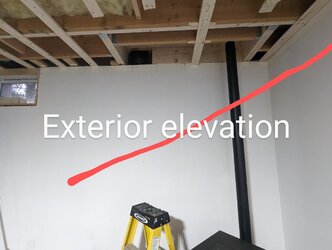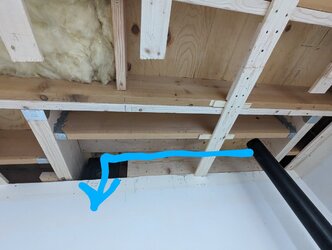Installing new stove in my basement, using Pelletvent Pro pipe which is listed as 1" clearance to combustibles. To meet all clearance requirements and have the stove in the corner, I need to run a 3' horizontal section through a 2x10 joist cavity (blue line). I reframed the joists to create the cavity shown.
Red line is the approximate grading outside, which is why I can't go straight out (wanted to avoid exterior vertical run) , and running it 3' horizontal will get me to a spot that's 3 feet off the ground (the clearance requirement for venting straight out horizontally).
I have at least 2-3" of clearance everywhere within this cavity, exceeding the 1" manufacturer requirement.
While getting ready to dryfit, I re-read everything I could find from manufacturer and elsewhere, and on a random stove retailer site, THEIR instructions for this pipe says "horizontal runs need to be 7" above combustibles and 9" below combustibles, or have heat shielding installed". Can't find anything from the manufacturer of the pipe or pellet stove saying the same, all just reference the "1" clearance to combustibles", not specifying if that's for both vertical and horizontal applications.
I'm the type to over engineer everything (I am an engineer), so I want to do it right and not burn the house down. Inspector wasn't knowledgeable, just said follow manufacturers clearances


Red line is the approximate grading outside, which is why I can't go straight out (wanted to avoid exterior vertical run) , and running it 3' horizontal will get me to a spot that's 3 feet off the ground (the clearance requirement for venting straight out horizontally).
I have at least 2-3" of clearance everywhere within this cavity, exceeding the 1" manufacturer requirement.
While getting ready to dryfit, I re-read everything I could find from manufacturer and elsewhere, and on a random stove retailer site, THEIR instructions for this pipe says "horizontal runs need to be 7" above combustibles and 9" below combustibles, or have heat shielding installed". Can't find anything from the manufacturer of the pipe or pellet stove saying the same, all just reference the "1" clearance to combustibles", not specifying if that's for both vertical and horizontal applications.
I'm the type to over engineer everything (I am an engineer), so I want to do it right and not burn the house down. Inspector wasn't knowledgeable, just said follow manufacturers clearances




